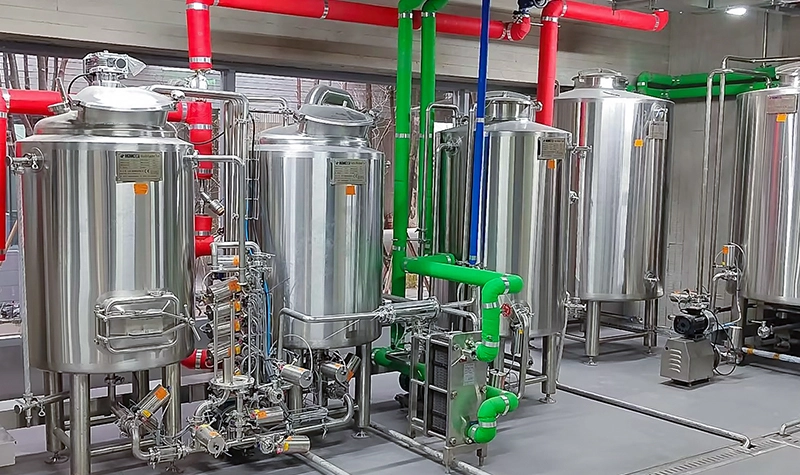Dreaming of starting your own brewery but overwhelmed by the details? Confused about the right equipment, cost, or even how to brew your first great beer? This guide walks you step-by-step through every stage of a successful micro brewery setup, helping you avoid common pitfalls and get your brewery off the ground.
How do you set up a micro brewery?
To set up a micro brewery, create a business plan, select the right micro brewery equipment, design your brewing system layout, and follow an optimized brewing process for craft beer. From choosing stainless steel fermenters to packaging bottles and kegs, every decision shapes your future brewing business success.
How to start a microbrewery business in six steps
Setting up a microbrewery requires careful planning and legal considerations, as well as a whole lot of determination. We’ve distilled how to turn your hobby into a business in six key steps.
Step 1: Create a business plan
Just like with starting any business, the success of your microbrewery hinges on your business plan.
Your business plan will act as a roadmap for your microbrewery. It’ll help you navigate the complexities of the industry by forcing you to distil information about your microbrewery’s vision, finances, and target audience into one document.
Your business plan should include a company description, a summary of your objectives and financial forecasts, information about your target audience, and detailed descriptions of the beers you plan to brew.
Step 2: Find a location
Location is everything when it comes to setting up a microbrewery. Not only will it determine the price of your rent and property prices, but it will also impact delivery logistics and foot traffic, if you’re considering opening up a taproom.
When deciding on a location, you should consider a variety of factors, including:
Zoning laws
Support from local authorities
The cost of renting or purchasing property
Accessibility for deliveries
The feel and popularity of the neighbourhood (for business owners setting up a taproom)
Zoning laws are particularly important to watch out for, as they dictate whether manufacturing and retail will be permitted in a specific area. We recommend contacting your local authority early to obtain information about necessary licenses and to check whether you’ll be able to brew in your chosen neighbourhood.
if you’re looking to avoid sky-high rent prices and endless competition, opting for a smaller location could give you access to more loyal, local customers while lowering your operating costs.
Step 3: Sourcing equipment and ingredients
Once you’ve pinned down a location, it’s time to get yourself set up.
Launching a brewery requires a significant investment in equipment and ingredients. And just like with anything, skimping on these investments could impact the quality of your final product.
As a general rule of thumb, you’ll need the following equipment to kickstart your microbrewery journey: a mash tun, a later tun, brew kettles, fermenters, and conditioning tanks.
Other essentials include a water treatment system, depending on the quality of the water in your location, basic laboratory equipment, safety tools, and cleaning and sanitisation supplies.
For ingredients, you’ll need to source a steady supply of malted barley, hops, yeast, water, brewing salts, and specific fruits, herbs, or spices if you’re developing a beer with unique flavour profiles.
Depending on your budget constraints and the ingredients you require, you’ll have to choose whether to opt for wholesale or local suppliers. Establishing relationships with reliable suppliers is also a crucial component of this step, as it can significantly impact your outgoing costs, as well as the quality and consistency of your products.
Step 4: Obtain licensing and legal requirements
Setting up a microbrewery requires you to navigate a range of national and local regulations. So, before you showcase your brew to the world, you’ll have to sort out the legal nitty-gritty.
Here’s a list of actions you’ll need to take to get your products fit for the shelf or taproom:
Register your brewery – for tax reasons, you’ll need to register your brewery with HM Revenue and Customs (HMRC) before you produce any beer.
Apply for relevant licences – a number of licences are required to ensure that your business is operating legally, including a HMRC Alcohol production licence, a Premises Licence from your local authority (if you plan on selling alcohol on or off the premises), a Personal Licence, and relevant planning permission.
Adhere to health and safety standards – you’re also legally obliged to carry out risk assessments and adhere to a wide range of health, safety, and welfare regulations to mitigate potential risks.
Other potential regulations to be aware of include Provision and Use of Work Equipment Regulations (PUWER), fire safety regulations, and environmental permits, depending on the nature of your operation.
Step 5: Market your microbrewery
The reality is that in the craft beer world, your brew only represents half of the equation.
To break through the increasingly saturated market, you’ll need a unique concept capable of resonating with your audience before you even get eyeballs on your product.
Your brewing philosophy should be the cornerstone of your brand strategy. What makes your beer unique? What are your core values? What story are you trying to tell? These are factors you need to communicate through your name, logo, and messaging in order to capture the attention of loyal buyers.
Making a name for yourself in your local community is essential, too. You can do this by collaborating with local businesses like the fast-growing brewer JUBEL, hosting taproom events like tasting and tours, and supporting local initiatives.
Step 6: Decide on a distribution model
If you haven’t already, you’ll need to decide on how to distribute your products.
For instance, do you want to sell directly through the taproom, deliver your beer to local shops, pubs, and restaurants, partner with a regional or national distributor, or sell online to increase your microbrewery’s reach?
When choosing a distribution model, you should consider the scale of your production, the financial resources at your disposal, and your target market. For example, if your brewery is community-focused, selling locally might make the most sense, while beers with unique concepts or flavour profiles might perform better online.
You’ll also need to decide if you want to keg, bottle, or can your beer. In both cases, opting for a hybrid approach is often the most sensible as it allows you to cater your distribution model to the unique needs of your brewery.

Case Study: Small Brewery Success Story
Background:
july, a passionate home brewer, wanted to start brewing commercially. She invested in a 500L micro brewery setup with stainless steel fermenters, a brewtech control system, and a small taproom.
Process:
Developed a clear business plan with help from local craft brewers.
Chose scalable micro brewery equipment for flexibility and future expansion.
Focused on local ingredients and small-batch experimentation.
Used social media to promote launch events and limited-edition ales.
Results:
Broke even in 18 months, expanded product range to kombucha and cider.
Won local craft beer awards, secured distribution deals with restaurants.
By focusing on quality, community, and continuous learning, July’s microbrewery became a regional favorite—proof that with the right plan and equipment, new brewery owners can succeed.
The most important thing is that she chose the brewing system and equipment of hgmc.
Shandong HG Engineering Equipment Co., Ltd. is the world’s leading manufacturer of beer brewing equipment. Hgmc produce brewery equipment, beverage equipment and canning/bottling lines. We have more than 30 national authorized patents and more than 20 high-tech achievements. We provide a full range of services, including individual equipment and turnkey projects. All products are in compliance with the ISO9001: 2015 quality management system, exported to more than 120 countries in the world, and have won recognition and praise from customers.
300L Beer Brewing Equipment
500L Beer Brewing Equipment
1000L Beer Brewing Equipment
2000L Beer Brewing Equipment
